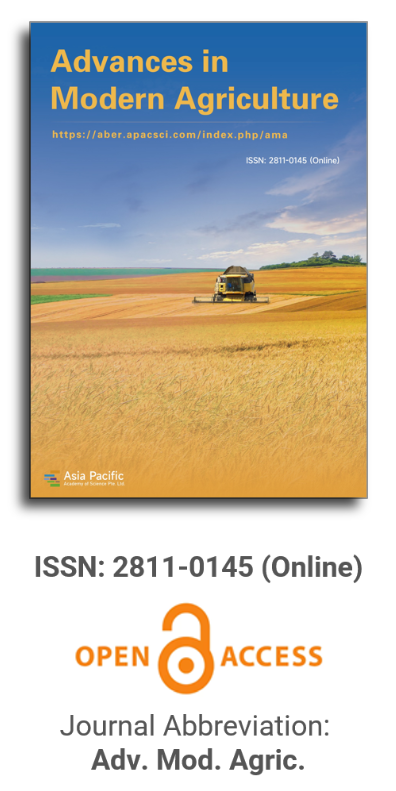


Application of discrete element method in agricultural engineering
Vol 2, Issue 2, 2021
VIEWS - 7178 (Abstract)
Download PDF
Abstract
The basic principles of the discrete element method were summarized, and commonly used software and its characteristics were introduced. The application of the discrete element method in tillage, planting, harvesting, and other agricultural machinery R&D was reviewed. Typical examples of the application of the discrete element method in agricultural machinery research and design at home and abroad were discussed and analyzed. Application prospect and trend of discrete element method in the field of agricultural engineering were prospected in order to provide reference for further development of modern agricultural equipment digital design.
Keywords
References
- Zhang G. Digital design technology and its application in agricultural machinery design. Agricultural Technology & Equipment 2019; 4: 14–16, 21.
- Wang W, Li X. A review on fundamentals of distinct element method and its applications in geotechnical engineering. Geotechnical Engineering Technique 2005; 19(4): 177–181.
- Chen C, Luo W, Tang S, et al. Drainage layout in paddy fields meeting machinery harvest requirement based on DRAINMOD model. Transactions of the Chinese Society of Agricultural Engineering 2018; 34(14): 86–93.
- Lu Z, Negi SC, Jofriet JC. A numerical model for flow of granular materials in silos. part 1: Model development. Journal of Agricultural Engineering Research 1997; 68(3): 223–229.
- Ucgul M, Fielke JM, Saunders C. 3D DEM tillage simulation: Validation of a hysteretic spring (plastic) contact model for a sweep tool operating in a cohesionless soil. Soil and Tillage Research 2014; 144: 220–227.
- Fang H, Ji C, Chandio FA. Analysis of soil dynamic behavior during rotary tillage based on distinct element method. Transactions of the Chinese Society for Agricultural Machinery 2016; 47(3): 22–28.
- Zhu Y, Xia J, Zeng R, et al. Prediction model of rotary tillage power consumption in paddy stubble field based on discrete element method. Transactions of the Chinese Society for Agricultural Machinery 2020; 51(10): 42–50.
- Xiong P, Yang Z, Sun Z, et al. Simulation analysis and experiment for three-axis working resistances of rotary blade based on discrete element method. Transactions of the Chinese Society of Agricultural Engineering 2018; 34(18): 113–121.
- Qin K, Ding W, Fang Z, et al. Design and experiment of plowing and rotary tillage combined machine. Transactions of the Chinese Society of Agricultural Engineering 2016; 32(16): 7–16.
- Yuan J, Yu J. Analysis on operational process of selfexcited vibrating subsoiler based on DEM-MBD coupling algorithm. Transactions of the Chinese Society for Agricultural Machinery 2020; 51(S2): 17–24.
- Ding L, Yang L, Wu D, et al. Simulation and experiment of corn air suction seed metering device based on DEM-CFD coupling method. Transactions of the Chinese Society for Agricultural Machinery 2018; 49(11): 48–57.
- Shi L, Wu J, Sun W, et al. Simulation test for metering process of horizontal disc precision metering device based on discrete element method. Transactions of the Chinese Society of Agricultural Engineering 2014; 30(8): 40–48.
- Liu C, Wei D, Du X, et al. Design and test of wide seedling strip wheat precision hook-hole type seed-metering device. Transactions of the Chinese Society for Agricultural Machinery 2019; 50(1): 75–84.
- Wang J, Tang H, Wang Q, et al. Numerical simulation and experiment on seeding performance of pickup finger precision seed-metering device based on EDEM. Transactions of the Chinese Society of Agricultural Engineering 2015; 31 (21): 4350.
- Shi S, Zhang D, Yang L, et al. Simulation and verification of seed-filling performance of pneumatic-combined holes maize precision seed-metering device based on EDEM. Transactions of the Chinese Society of Agricultural Engineering 2015; 31(3): 62–69.
- Lai Q, Yu Q, Su W, et al. Design and experiment of air-suction ultra-narrow-row device for precise panax notoginseng seed metering. Transactions of the Chinese Society for Agricultural Machinery 2019; 50(4): 102–112.
- Lai Q, Ma W, Liu S, et al. Simulation and experiment on seed-filling performance of pneumatic disc seed-metering device for mini-tuber. Transactions of the Chinese Society of Agricultural Machinery 2017; 48(5): 44–53.
- Wang Y, Li H, He J, et al. Parameters optimization and experiment of mechanical wheat shooting seed-metering device. Transactions of the Chinese Society of Agricultural Engineering 2020; 36(21): 1–10.
- Lu F, Ma X, Qi L, et al. Theory and experiment on vibrating small-amount rice sowing device. Transactions of the Chinese Society for Agricultural Machinery 2018; 49(6): 119–128, 214.
- Li Y, Wei Y, Yang L, et al. Design and experiment of mung bean precision seed-metering device with disturbance for promoting seed filling. Transactions of the Chinese Society for Agricultural Machinery 2020; 51(S1): 43–53.
- Wang W, Liu W, Yuan L, et al. Simulation and experiment of single longitudinal axial material movement and establishment of wheat plants model. Transactions of the Chinese Society for Agricultural Machinery 2020; 51(S2): 170–180.
- Wei Z, Su G, Li X, et al. Parameter optimization and test of potato harvester wavy sieve based on EDEM. Transactions of the Chinese Society for Agricultural Machinery 2020; 51(10): 109–122.
- Dai F, Zhao W, Han Z, et al. Improvement and experiment on 4GX-100 type wheat harvester for breeding plots. Transactions of the Chinese Society for Agricultural Machinery 2016; 47(S1): 196–202.
- Mou X, Jiang H, Sun Y, et al. Simulation optimization and experiment of disc-type grain crushing device of silage corn harvester. Transactions of the Chinese Society for Agricultural Machinery 2020; 51(S1): 218–226.
- Liu X, Ding Y, Shu C, et al. Design and experiment of spiral disturbance cone centrifugal fertilizer apparatus. Transactions of the Chinese Society of Agricultural Engineering 2020; 36(2): 40–49.
- Yuan J, Yin R, Liu G, et al. Design and experiment of In-situ fertilizer mixing integrated digging and backfilling for fruit tree planter. Transactions of the Chinese Society for Agricultural Machinery 2021; 52(2): 110–121.
- Shi Y, Chen M, Wang X, et al. Analysis and experiment of fertilizing performance for precision fertilizer applicator in rice and wheat fields. Transactions of the Chinese Society for Agricultural Machinery 2017; 48(7): 97–103.
- Zhang X, He G, Feng C, et al. Design and experiment of flights in middle drum of triple-pass rotary drum dryer for organic fertilizer pellets. Transactions of the Chinese Society for Agricultural Machinery 2016; 47(7): 151–158.
- Liu H, Gong Y, Zhang B, et al. Design and optimization of working parameters of fry sorting machine based on EDEM. Transactions of the Chinese Society for Agricultural Machinery 2020; 51(1): 114–121.
- Lei X, Li M, Zhang L, et al. Design and experiment of horizontal pneumatic screw combination adjustable quantitative fertilizer feeding device for granular fertilizer. Transactions of the Chinese Society of Agricultural Engineering 2018; 34(19): 9–18.
- Wan L, Xie D, Li Y, et al. Design and experiment of roller hole fertilizer application between corn rows. Transactions of the Chinese Society for Agricultural Machinery 2020; 51(11): 64–73.
- Zhang X, Liu Y, Li L, et al. Design and performance experiment of multi-segment type auger in process of organic fertilizer production. Transactions of the Chinese Society of Agricultural Engineering 2018; 34(3): 49–56.
Supporting Agencies
Copyright (c) 2021 Lintao Chen, Xiangwei Mou, Zhujing Peng

This work is licensed under a Creative Commons Attribution 4.0 International License.

This site is licensed under a Creative Commons Attribution 4.0 International License (CC BY 4.0).

Prof. Zhengjun Qiu
Zhejiang University, China

Cheng Sun
Academician of World Academy of Productivity Science; Executive Chairman, World Confederation of Productivity Science China Chapter, China
Indexing & Archiving
In the realm of modern agriculture, the integration of cutting-edge technologies is revolutionizing the way we approach sustainable farming practices. A recent study published in Advances in Modern Agriculture titled "Classification of cotton water stress using convolutional neural networks and UAV-based RGB imagery" has garnered significant attention for its innovative approach to precision irrigation management. Conducted by researchers from Institute of Data Science and the AgriLife Research and Extension Center of Texas A&M University (authors's information is below). This study introduces a novel method for classifying cotton water stress using unmanned aerial vehicles (UAVs) and convolutional neural networks (CNNs), offering a powerful solution for optimizing water use in agriculture.
Modern agricultural technology is evolving rapidly, with scientists collaborating with leading agricultural enterprises to develop intelligent management practices. These practices utilize advanced systems that provide tailored fertilization and treatment options for large-scale land management.
This journal values human initiative and intelligence, and the employment of AI technologies to write papers that replace the human mind is expressly prohibited. When there is a suspicious submission that uses AI tools to quickly piece together and generate research results, the editorial board of the journal will reject the article, and all journals under the publisher's umbrella will prohibit all authors from submitting their articles.
Readers and authors are asked to exercise caution and strictly adhere to the journal's policy regarding the usage of Artificial Intelligence Generated Content (AIGC) tools.
Asia Pacific Academy of Science Pte. Ltd. (APACSCI) specializes in international journal publishing. APACSCI adopts the open access publishing model and provides an important communication bridge for academic groups whose interest fields include engineering, technology, medicine, computer, mathematics, agriculture and forestry, and environment.



.jpg)
.jpg)

.jpg)
